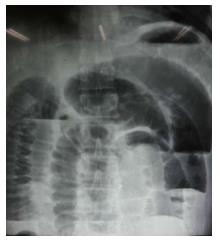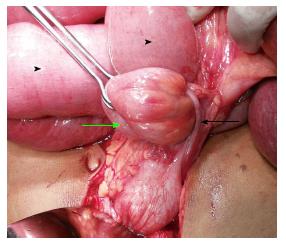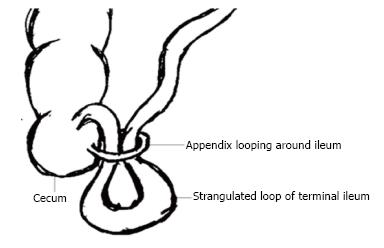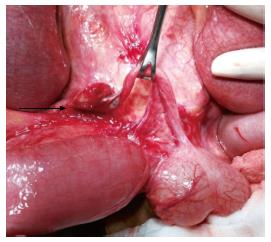Published online Apr 27, 2015. doi: 10.4240/wjgs.v7.i4.67
Peer-review started: December 13, 2014
First decision: December 26, 2014
Revised: January 25, 2015
Accepted: February 9, 2015
Article in press: February 11, 2015
Published online: April 27, 2015
Processing time: 117 Days and 19.5 Hours
Acute appendicitis is the most common surgical emergency that we encounter. Adynamic Intestinal obstruction due to appendicitis or its complication may be seen time and often. Mechanical obstruction because of appendicitis is uncommon and even rarer for a closed loop obstruction to occur. Although it was described as early as 1901, very few cases have been reported. We report the case of a 20 years male who presented with generalized colicky pain abdomen, abdominal distension, vomiting and obstipation for three to four days. Vital signs were stable. His abdomen was distended and peritonitic, especially in the right iliac fossa. Rest of the physical examination was unremarkable. Blood tests were normal except for leucocytosis with neutrophilia. An abdominal X-ray finding was indicating a small bowel obstruction. A midline laparotomy was performed. On intraoperative examination, distended loops of small bowel from the jejunum to the distal ileum was observed, and a constricting ring around the terminal ileum created by a phlegmonous appendicitis with its tip adherent to the root of mesentery was found, obstructing an edematous loop of small bowel without signs of ischemia. As the bowel was viable simple appendectomy was done. Postoperatively, he had an uneventful recovery and was discharged after 3 d.
Core tip: It is safe to say, almost no-one will become a surgeon without seeing or doing appendectomy. It is so common, yet time and often we are deceived by it. As we know, abdomen is a “Pandora’s box”, we never know what come up sometimes and this is a perfect example. We report a case of mechanical small bowel obstruction due to acute appendicitis that was timely and successfully managed surgically.
- Citation: Awale L, Joshi BR, Rajbanshi S, Adhikary S. Appendiceal tie syndrome: A very rare complication of a common disease. World J Gastrointest Surg 2015; 7(4): 67-70
- URL: https://www.wjgnet.com/1948-9366/full/v7/i4/67.htm
- DOI: https://dx.doi.org/10.4240/wjgs.v7.i4.67
Acute appendicitis is one of the most common surgical problems that we encounter. Diagnosis is not always so straightforward and can impose a dilemma. Indeed appendicitis is well known to cause mechanical small bowel obstruction because of adhesion. On the contrary, very few cases of mechanical small bowel obstruction developed as a direct result of acute appendicitis have been reported in literature[1,2]. In 1901, Hotchkiss et al[3] first reported it but till date only a handful of cases has been reported. The clinical feature of small bowel obstruction may obscure the clinical picture of appendicitis, making its diagnosis further challenging if not impossible. Hence, the preoperative diagnosis is very difficult and is made during laparotomy. Its paucity makes this case interesting.
A 20 years young male presented with the four days history of worsening generalized colicky pain abdomen, three days history of abdominal distension and bilious vomiting and three days history of obstipation. There was no history of previous abdominal surgery. On examination he was afebrile and vital signs were stable. His abdomen was distended, with visible bowel loops remarkably in the center abdomen and peritonitic, especially in the right iliac fossa, with exaggerated bowel sound. The rectal examination was normal. Rest of the physical examination was unremarkable. Laboratory parameters were within normal limits, except for the leukocytosis (16800/μL) with neutrophilia. A plain abdominal skiagram (Figure 1) showed dilated jejunal and ileal loops with multiple air-fluid levels indicating a small bowel obstruction.
The patient was kept nil per oral with active nasogastric aspiration. Intravenous fluid, prophylactic intravenous antibiotics and analgesics were started. Meanwhile the patient was planned for emergency laparotomy with a diagnosis of mechanical small bowel obstruction of unknown etiology.
A midline laparotomy was performed. On intraoperative examination, distended loops of small bowel from the jejunum to the distal ileum were observed. These loops were followed distally to reveal a constricting ring around the terminal ileum (Figure 2) created by a phlegmonous appendicitis (as represented in Figure 3) with its tip adherent to the root of mesentery (Figure 4), obstructing an edematous loop of terminal ileum without signs of ischemia (Figure 2). As the bowel was viable simple appendectomy was done and the abdomen was closed with a drain in the pelvis.
Postoperatively, he had an uneventful recovery. The drain was removed on the 2nd operative day, and was orally started after around 48 h with the evidence of bowel movement. Subsequently, he was discharged on the 4th postoperative day. Histopathology report of excised appendix revealed acute appendicitis. He was doing well till 2 mo.
The first case of intestinal obstruction due to acute appendicitis was described by Hotchkiss[3]. In 1909, Hawks[4] divided the causes into mechanical and septic appendicitis or a combination of both. Appendix is a mobile organ and has variable position. Hence, during appendicitis it has tendency to get adhere to surrounding structures resulting in mechanical small bowel obstruction, and an increased length seems to facilitate the phenomenon[5].
In 2009, Bhandari et al[6] classified intestinal obstruction because of appendicitis into four types: adynamic, mechanical, strangulation, and caused by mesenteric ischemia. Adynamic obstruction or paralytic ileus is undoubtedly the most common type and is due to the appendicular inflammation spreading to the surrounding structures (caecum, small bowel or posterior peritoneum). Strangulation may result from a long standing closed loop obstruction, which can be due to the long appendix constricting around a loop of small bowel, or when it is adhere to surrounding structures and a part of bowel herniates through the gap. In 2005, Assenza et al[5] reported only six such cases in the review. Mesenteric ischemia due to appenditis causing intestinal obstruction is the rarest one.
Among the mechanical causes, the vast majority are due to the formation of appendicular abscess that compresses the loops of small bowel, and postoperative adhesions that occur years after treatment[6]. There are two basic situations where the appendix may also cause a mechanical obstruction[5]; appendicular tip attached to the mesentery surrounding an ileal loop, producing compression of its lumen and the appendicular tip attached to the intestinal serosa, producing the obstruction by direct compression or torsion of a loop. There are only ten cases reported in literature reviewed by O’Donnell et al[2], i.e., a loop obstruction caused by the loop of the appendix attached to the mesentery, in the context of acute appendicitis, which is similar to the one in our case.
The paucity of this condition makes it very challenging in making its preoperative diagnosis. In the early inflammation phase, CT (Computerized Tomography) may help to clinch the diagnosis. After resolution of appenditis, its role is very limited[5-7]. Thorough history and clinical examination, imaging findings and high index of suspicion may help in diagnosis. Diagnostic laparoscopy may be a valuable option.
Treatment is straightforward and depends on intraoperative findings. Appendectomy is sufficient if intervened early, as in our case. It may require small bowel or ileocaecal resection when there is strangulation.
Closed loop and strangulating obstruction of the small bowel are serious lesions that require emergency surgery. An accurate and early diagnosis of intestinal strangulation is essential in patients with small bowel obstruction to minimize the risks of morbidity and mortality. Delayed operation potentially results in high mortality. Preoperative, diagnosis of Appendiceal tie syndrome[7] is always difficult. Early surgical intervention in case of small bowel obstruction can reduce the postoperative risk.
A 20 years young male presented with generalized colicky pain abdomen, abdominal distension, bilious vomiting and obstipation.
Acute abdomen, Mechanical small bowel Intestinal obstruction.
Congenital anomalous bands, Intestinal malrotation.
Laboratory tests showed a leukocytosis (16800/μL; 4000-11000) rest within normal range (including haemoglobin, haematocrit, creatinine, ABG analysis).
An abdominal X-ray radiography indicated remarkably multiple air-fluid levels.
Pathology findings indicated acute appendicitis.
Appendectomy.
Acute appendicitis, as a cause of mechanical small bowel obstruction is very rare. Long inflamed appendix may lead to this problem. Close loop obstruction by loop of the appendix, in the context of appendicitis, is even rarer. A literature review in 2005 identified only six such cases leading to strangulation.
Appendiceal tie syndrome also called as appendicular band or knot syndrome is an extremely rare surgical entity, in which there is entrapment of bowel loop by the appendix, acting as constricting ring, and may lead to its strangulation.
Sometimes a very common disease like appendicitis can surprise you with its very rare presentation. But the key thing is the early intervention before it really does the damage, that is, to prevent strangulation.
This manuscript is a well designed with visual materials and will contribute to the literature.
P- Reviewer: Bandyopadhyay SK, Ince V, Petronella P, Steele SR S- Editor: Ji FF L- Editor: A E- Editor: Lu YJ
| 1. | Harris S, Rudolf LE. Mechanical small bowel obstruction due to acute appendicitis: review of 10 cases. Ann Surg. 1966;164:157-161. [PubMed] |
| 2. | O’Donnell ME, Sharif MA, O’Kane A, Spence RA. Small bowel obstruction secondary to an appendiceal tourniquet. Ir J Med Sci. 2009;178:101-105. [RCA] [PubMed] [DOI] [Full Text] [Cited by in Crossref: 17] [Cited by in RCA: 21] [Article Influence: 1.2] [Reference Citation Analysis (0)] |
| 3. | Hotchkiss LW. V. Acute Intestinal Obstruction following Appendicitis. A Report of Three Cases Successfully Operated upon. Ann Surg. 1901;34:660-677. [PubMed] |
| 4. | Hawkes F. III. The Prevention of Intestinal Obstruction Following Operation for Appendicitis. Ann Surg. 1909;49:192-207. [PubMed] |
| 5. | Assenza M, Ricci G, Bartolucci P, Modini C. Mechanical small bowel obstruction due to an inflamed appendix wrapping around the last loop of ileum. G Chir. 2005;26:261-266. [PubMed] |
| 6. | Bhandari L, Mohandas P. Appendicitis as a cause of intestinal strangulation: a case report and review. World J Emerg Surg. 2009;4:34. [RCA] [PubMed] [DOI] [Full Text] [Full Text (PDF)] [Cited by in Crossref: 23] [Cited by in RCA: 31] [Article Influence: 1.9] [Reference Citation Analysis (0)] |
| 7. | Menon T, Martin RJ, Cameron D, Rao S. Appendiceal tie syndrome. Australas Radiol. 2007;51 Spec No:B133-B136. [PubMed] |
















